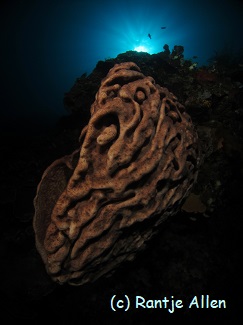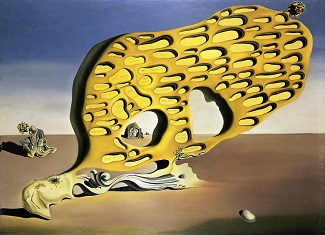Loading content - please wait...
Salvador Dali sponge identified
Salvador Dali sponge is our name for the strikingly beautiful sponge found in Gorontalo. However, we now know its proper scientific name, Petrosia lignosa.
Initial Discovery
In May 2003, Miguel’s Diving flew Massimo Boyer to Gorontalo to take underwater photographs. These photographs would begin our archives of local marine life. As a marine biologist based in Manado, Massimo quickly spotted marine life uncommon or missing from Bunaken Marine Park. Giant, strangely formed sponges grabbed his attention. He had never seen anything like them, although they could be easily found on Gorontalo’s pristine walls.

The sponge that so struck Massimo we called Salvador Dali. The surreal surfaces of this sponge reminded us of the Spanish painter by that name.
Scientific Investigation
In order to discover the identity of this unusual sponge, we sent two samples to Nicole J. de Voogd. She was studying sponges at the Institute for Biodiversity and Ecosystem Dynamics, Zoological Museum, University of Amsterdam. The interior bodies of sponges are composed of mazes of microscopic spicules. Each sponge species has a unique pattern. After looking at the two samples we sent under a microscope, Nicole could identify our Salvador Dali sponge. It is Petrosia lignosa.
The genus name Petrosia actually means “stony hard.” When compared with other sponges, all Petrosid sponges are hard and rock-like. So far, Petrosia lignosa is known only from vertical walls in eastern Indonesia. It was first described in 1925 from the Togian Islands, south of Gorontalo. However, in other locations this sponge lacks the distinctive swirls found on our Salvador Dali sponges. As a result, Massimo stated that he had not observed any in Bunaken dive sites.

No one knows why this sponge looks so surreal here in Gorontalo. According to Nicole, “Salvador Dali” would be a locally unique morphology of Petrosia lignosa.
Gorontalo’s Salvador Dali sponge
The extensive vertical walls of Gorontalo host many fine examples of our Salvador Dali sponge. This sponge is usually found below 20 meters in deeper water. Divers will notice that the sponge starts from a small base and grows wide and large. This means the sponge becomes off-weighted. During seasonal storms, wave action can make a Salvador Dali sponge move back and forth. Since its base is not flexible, it can snap off and break. The giant sponge will die and turn to dust within a few weeks.
We took the samples Nicole saw from the Traffic Jam dive site. Both sponges live at 20 meters on a wall exposed to the open ocean. The smaller sponge is shaped like a squashed vase, measuring about 40 cm tall. It has light-colored skin. The other one forms a long tube or funnel and is almost one meter long with dark skin. Advanced divers can see larger ones below 30 meters. Sponge samples were taken in such a way as not to be noticed by passing divers.
To see a Salvador Dali sponge, please make your dive reservations and join us for some great diving. Thanks, Nicole, for your help. And our prayers for the safe delivery of your baby!






Sorry, comments are closed for this post.